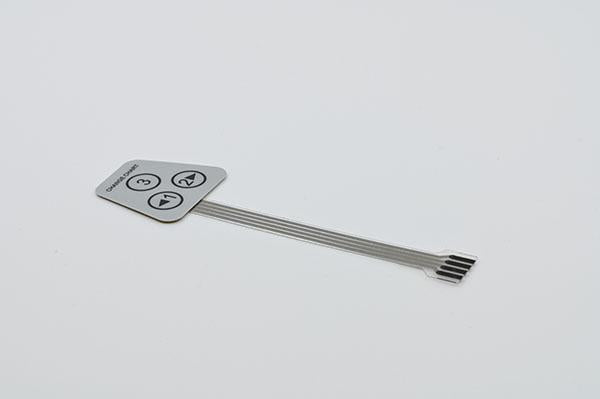Explore the Benefits of Using a Membrane Switch in Modern Devices
Wiki Article
Comprehending Membrane Layer Switches: The Trick to Reliable and long lasting Controls
What Are Membrane Layer Buttons?
Membrane layer switches are an advanced option in the world of user interface technology, integrating performance and layout seamlessly. These devices act as an interface between individuals and digital systems, integrating several components into a small style. Commonly constructed from flexible, thin layers of materials, membrane buttons are designed to respond to touch, enabling users to interact with machinery and electronic tools effectively.The primary elements of a membrane layer button consist of a published circuit layer, visuals overlay, and a spacer layer that stops unexpected activation. The visuals overlay can be personalized to show brand identity or customer choices, improving appearances while making certain use. Membrane layer switches are typically utilized in various applications, consisting of clinical gadgets, consumer electronic devices, and commercial devices, owing to their toughness and resistance to ecological elements such as moisture and dust.
Among the vital benefits of membrane switches is their ability to hold up against damage, making them excellent for high-traffic settings. Furthermore, they are lightweight and call for very little space, enabling ingenious designs in item advancement. In general, membrane layer switches over represent a functional and reliable option for modern-day electronic user interfaces, marrying innovation with user-centric layout concepts.
Exactly How Membrane Layer Changes Job
The procedure of membrane layer changes hinges on a basic yet reliable device that converts customer input into electronic signals. When an individual presses the button, the leading layer warps, permitting a conductive element in the circuit layer to make call with a corresponding conductive pad on the bottom of the graphic overlay.The design of membrane layer buttons can differ, but they often integrate domes or responsive components to supply comments to the user, boosting the overall experience - membrane switch. The products utilized in membrane switches, such as polyester or polycarbonate, add to their resilience and resistance to ecological factors, consisting of wetness and dust. The published circuits are typically enveloped, which safeguards them from wear and tear over time.
Benefits of Membrane Layer Switches

Furthermore, membrane layer buttons are recognized for their sturdiness. Constructed from durable products, they are immune to dust, wetness, and physical wear, which significantly prolongs their life-span contrasted to typical mechanical buttons. This toughness makes them especially appropriate for high-traffic environments and applications needing long life.
One more substantial benefit is the ease of cleaning and maintenance. The smooth surface of membrane layer changes lessens dust buildup and is frequently unsusceptible spills, making them ideal for settings that call for regular sanitization.
Furthermore, membrane layer buttons provide a structured account, bring about a thinner style that can be integrated right into various tools without adding bulk. This function not only boosts the visual allure yet likewise adds to a much more ergonomic item layout.
Applications of Membrane Layer Buttons
User-friendly and versatile, membrane buttons locate applications across a large range of markets, consisting of clinical gadgets, customer electronic devices, and commercial devices. In the medical field, these switches are essential to tools such as analysis devices, client monitoring systems, and mixture pumps, where reliability and ease of cleaning are important. Their capacity to withstand extreme settings and maintain functionality makes them ideal for such applications.
In customer electronic devices, membrane layer switches are utilized in items like microwaves, cleaning makers, and remotes - membrane switch. Their streamlined design permits instinctive individual interfaces, enhancing the general user experience while offering toughness and resistance to deterioration
Commercial equipment also benefits from membrane layer switches, particularly in control panels for equipment and automation systems. These buttons use protection against dirt and moisture, making certain constant performance in challenging atmospheres. Furthermore, their customizable functions permit producers to customize them to specific operational requirements, enhancing performance and capability.
Picking the Right Membrane Layer Switch Over
When picking a membrane button, it is vital to think about numerous elements that influence performance and viability for particular applications. The main considerations consist of ecological problems, responsive feedback, resilience, and layout requirements.
First, assess the operating environment; buttons revealed to dampness, chemicals, or extreme temperatures require specific materials to guarantee long life and functionality. Next, assess the need for tactile feedback. Relying on individual communication, some applications might take advantage of a tactile action to confirm activation, while others may favor a non-tactile design for visual reasons.
Resilience is an additional essential factor; membrane buttons need to be made to stand up to constant use, impacts, and abrasion. Guarantee the chosen button can withstand the see here now anticipated lifecycle, specifically in high-usage circumstances.

Conclusion
In verdict, membrane switches offer as important components in the style of trusted and durable control systems across different industries. The flexibility of membrane layer switches enables for customized solutions that meet details functional requirements, enhancing their value in modern technology.
Membrane layer switches represent a crucial facet of modern interface style, blending capability with resilience in different applications.Membrane layer buttons are an innovative remedy in the world of individual interface technology, useful link integrating functionality and layout perfectly. Typically constructed from versatile, thin layers of products, membrane buttons are created to react to touch, allowing customers to connect with machinery and electronic tools properly.
The style of membrane buttons can differ, however they commonly integrate domes or tactile elements to give responses to the user, improving the general experience.In conclusion, membrane layer changes serve as vital parts in the design of sturdy and reliable control Get More Information systems throughout various industries.
Report this wiki page